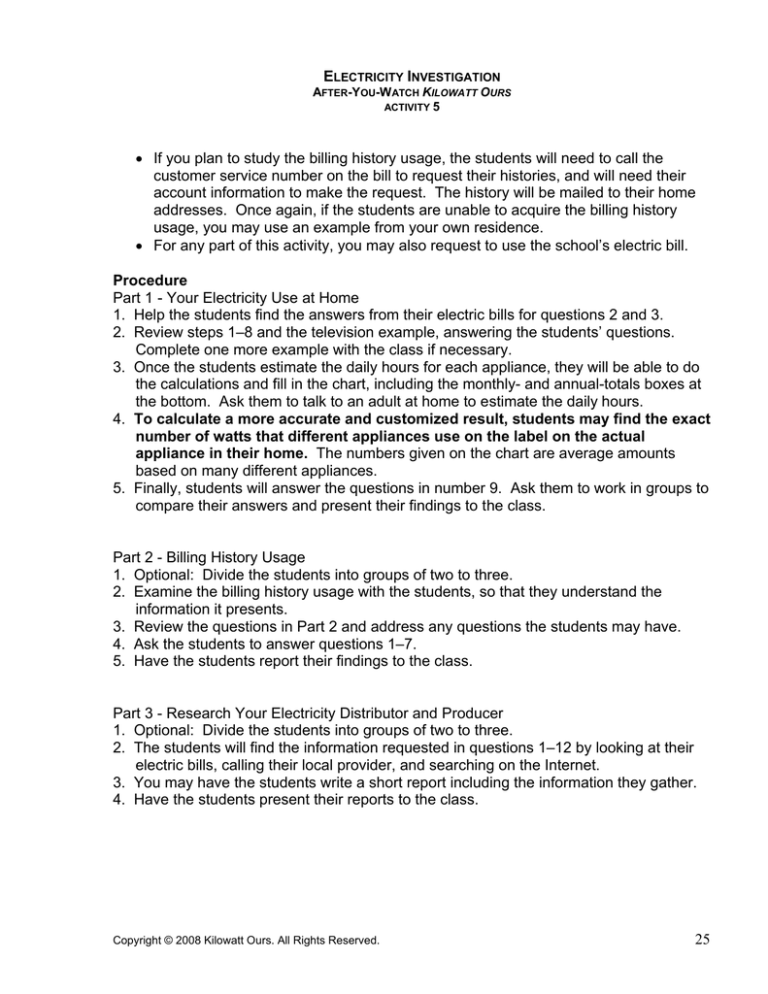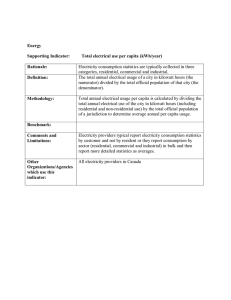
ELECTRICITY INVESTIGATION
AFTER-YOU-WATCH KILOWATT OURS
ACTIVITY 5
If you plan to study the billing history usage, the students will need to call the
customer service number on the bill to request their histories, and will need their
account information to make the request. The history will be mailed to their home
addresses. Once again, if the students are unable to acquire the billing history
usage, you may use an example from your own residence.
For any part of this activity, you may also request to use the school’s electric bill.
Procedure
Part 1 - Your Electricity Use at Home
1. Help the students find the answers from their electric bills for questions 2 and 3.
2. Review steps 1–8 and the television example, answering the students’ questions.
Complete one more example with the class if necessary.
3. Once the students estimate the daily hours for each appliance, they will be able to do
the calculations and fill in the chart, including the monthly- and annual-totals boxes at
the bottom. Ask them to talk to an adult at home to estimate the daily hours.
4. To calculate a more accurate and customized result, students may find the exact
number of watts that different appliances use on the label on the actual
appliance in their home. The numbers given on the chart are average amounts
based on many different appliances.
5. Finally, students will answer the questions in number 9. Ask them to work in groups to
compare their answers and present their findings to the class.
Part 2 - Billing History Usage
1. Optional: Divide the students into groups of two to three.
2. Examine the billing history usage with the students, so that they understand the
information it presents.
3. Review the questions in Part 2 and address any questions the students may have.
4. Ask the students to answer questions 1–7.
5. Have the students report their findings to the class.
Part 3 - Research Your Electricity Distributor and Producer
1. Optional: Divide the students into groups of two to three.
2. The students will find the information requested in questions 1–12 by looking at their
electric bills, calling their local provider, and searching on the Internet.
3. You may have the students write a short report including the information they gather.
4. Have the students present their reports to the class.
Copyright © 2008 Kilowatt Ours. All Rights Reserved.
25
STUDENT PAGE
ELECTRICITY INVESTIGATION
AFTER-YOU-WATCH KILOWATT OURS
ACTIVITY 5
Name________________________________________
Date__________________
Part 1 - Your Electricity Use at Home
1. Who pays the electric bill at your home? Ask that person for the last month’s bill.
2. How much do you pay per kilowatt-hour of electricity? _________________________
3. How many kilowatt-hours did your household use in one month? How much did you
pay for the kilowatt-hours you used for the month? ____________________________
4. Complete the table below by doing the calculations in steps 5, 6, 7 and 8 for each
appliance. Don’t forget to add more appliances from your home that are not listed, but
do not include appliances that use natural gas.
5. First find out how many watts each appliance uses and estimate how many hours per
day the item is used. If an appliance is used less than one hour per day, use
fractions. For example, perhaps your microwave is used only about 15 minutes in an
average day. You would write 0.25 in the Daily Hours box for the microwave.
6. Then calculate how much electricity different appliances in your home use in one
month and how much that costs.
Daily kWh = watts/1000 × hours/day = kWh/day
Monthly kWh = kWh/day × 30 days/month = kWh/month
Monthly Cost = kWh/month × $/kWh = $/month
7. Convert kWh into pounds of coal, carbon dioxide (CO2), sulfur dioxide (SO2), and
nitrogen oxides (NOx).
Monthly pounds of coal used = monthly kWh used (1 lb coal required
for 1 kWh)
Monthly pounds of CO2 emitted = monthly coal × 1.4 lb CO2/1 lb coal
Monthly pounds of SO2 emitted = monthly coal × 0.006 lb SO2/1 lb coal
Monthly pounds of NOx emitted = monthly coal × 0.003 lb NOx/1 lb coal
Kilowatt Ours Companion Curriculum National Edition
26
STUDENT PAGE
ELECTRICITY INVESTIGATION
AFTER-YOU-WATCH KILOWATT OURS
ACTIVITY 5
Name________________________________________
Date__________________
8. Finally, calculate the amounts for one year by multiplying by 12 months.
Here is an example to follow:
A television uses an estimated 250 watts. Let’s say your TV is turned on 4 hours per day.
If you pay $.08 per kilowatt-hour, your annual cost to run your TV would be $28.80.
Daily kWh = 250 watts/1000 × 4 hours/day = 1 kWh/day
Monthly kWh = 1 kWh/day × 30 days/month = 30 kWh/month
Monthly cost = 30 kWh/month × $.08/kWh = $2.40/month
Your estimated monthly cost to run the TV would be $2.40.
Your estimated annual cost to run the TV would be:
$2.40/month × 12 months/year = $28.80/year
The monthly emissions to run the TV would be:
Monthly coal = monthly kWh = 30 lb
Monthly CO2 = 30 lb coal × 1.4 lb CO2/1 lb coal = 42 lb CO2
Monthly SO2 = 30 lb coal × 0.006 lb SO2/1 lb coal = 0.18 lb SO2
Monthly NOx = 30 lb coal × 0.003 lb NOx/1 lb coal = 0.09 lb NOx
9. After you finish the calculations, answer these questions on a separate sheet of paper:
a) Compare your total calculated monthly kilowatt-hours and cost with your actual
monthly bill. What differences and similarities do you see?
b) Compare your totals with those of your classmates. What are the class averages?
c) Are your figures higher or lower than the class averages?
d) How do the number of watts and daily hours for each appliance affect the amount
of kilowatt-hours and emissions produced?
e) Which figures are most surprising or interesting to you?
f) What is “phantom load” and what can you do to reduce it?
g) Where in your home would it be easiest to reduce your electricity use?
h) What simple actions can you take to conserve electricity?
Copyright © 2008 Kilowatt Ours. All Rights Reserved.
27
STUDENT PAGE
ELECTRICITY INVESTIGATION
AFTER-YOU-WATCH KILOWATT OURS
ACTIVITY 5
Electricity Use in Your Home (do not include natural gas appliances)
Appliance
Television
Example
Clothes washer
Average Daily
Watts Hours
250
4
Daily
kWh
1
Monthly
kWh
30
Monthly
Cost ($)
2.40
Monthly
Coal (lb)
30
Monthly
CO2 (lb)
42
Monthly
SO2 (lb)
0.18
Monthly
NOx (lb)
0.09
500
(cold water)
Clothes dryer
5000
Dishwasher
2400
(hot wash/rinse)
Oven
3750
Stovetop range
500
Air conditioner
4000
(window)
Televisions
250
Microwave
1100
Lights (60-watt)
60
Lights (100-watt)
100
Ceiling fans
175
Box fans
125
Hair dryer
1500
Freezer
440
Vacuum cleaner
1000
Refrigerators
700
Hot water heater
4500
Toaster oven
1300
Stereo system
250
Computers
350
Clock radio
5
Blender
300
Monthly Totals
n/a
n/a
n/a
add columns
Annual Totals
n/a
n/a
n/a
multiply by 12
(Sources: Corn Husker Public Power District, Seattle City Light, and U.S. Department of Energy)
For appliances that are not listed, you can find the average wattage at these websites:
http://www.ci.seattle.wa.us/light/accounts/stretchyourdollar/ac5_appl.htm
http://www.cornhusker-power.com/householdappliances.asp
http://www.eere.energy.gov/consumer/your_home/appliances/index.cfm/mytopic=10040
Kilowatt Ours Companion Curriculum National Edition
28
STUDENT PAGE
ELECTRICITY INVESTIGATION
AFTER-YOU-WATCH KILOWATT OURS
ACTIVITY 5
Name________________________________________
Date__________________
Part 2 - Billing History Usage
1. Call your local electric utility to request a billing history usage for the last two years for
your home. The phone number is on your monthly bill, in the phone book, and at the
website. They will fax it or mail it to the fax number or mailing address you provide.
Write down the phone number. _________________________________________
2. When you receive the history, compare your electricity use for year one with year two.
Did your electricity use increase or decrease?
3. Compare each month throughout the year. What patterns do you see? How does
your usage change at different times of the year?
4. What ideas do you have about the patterns you see in your electricity use? What do
you think affected your electricity use in different months and in different years?
5. Calculate your average monthly electricity use and average monthly cost.
6. On a sheet of graph paper, create a bar or line graph for your electricity use, including
year one and year two.
7. What do you think you can do to lower your monthly usage?
Copyright © 2008 Kilowatt Ours. All Rights Reserved.
29
STUDENT PAGE
ELECTRICITY INVESTIGATION
AFTER-YOU-WATCH KILOWATT OURS
ACTIVITY 5
Name________________________________________
Date__________________
Part 3 - Research Your Electricity Distributor and Producer
Your electricity distributor is also called your local electric utility. Call or find the website
of your electricity distributor and try to find the answers to the following questions. You
may also need to research the electricity producer if it is separate from the distributor.
For example, in Nashville, Tennessee, Nashville Electric Service (NES) distributes
electricity to consumers. However, NES does not produce the electricity but buys it from
the Tennessee Valley Authority (TVA), which produces it from primary energy sources,
such as coal and wind.
1. Is your distributor a privately or publicly owned company? What does this mean?
2. How many customers does your distributor service supply?
3. Does the company produce its own electricity or buy it from a producer? Who is the
producer?
4. What primary energy sources are used to produce the electricity and what are the
percentages of each? (fossil fuels, nuclear, hydropower, solar, wind, methane…)
5. Where are the power-generation sites located (power plants, wind farms, reservoirs)?
6. Where do the fossil fuels or uranium originate?
7. Does the provider have a program that allows you to support green power sources?
What is it called and how does it work?
8. How does the price you pay for electricity compare with other parts of the country?
9. What sort of programs do the distributor and producer have to help protect the
environment and natural resources?
10. Find one more fact about how your electricity is produced and distributed that is
interesting to you. Has your electricity distributor or producer been in the news
lately? Why?
11. Find or create a map of the area your local provider serves. Label your town or city.
Draw arrows between the energy sources and your home, showing the percentage
of each source used. For example, coal from Appalachia may go to a power plant,
and the power goes to your home.
12. Research and explain the processes of producing electricity from coal, nuclear,
hydro, solar, wind, and methane energy sources.
Kilowatt Ours Companion Curriculum National Edition
30




